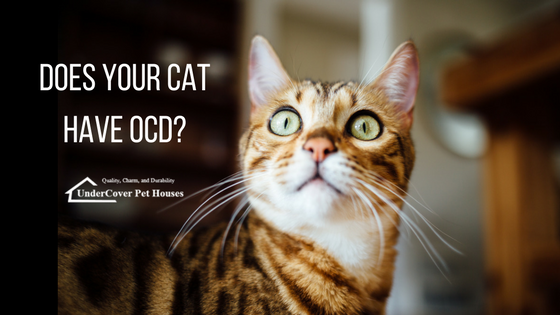 Loading... Please wait...
Loading... Please wait...Does Your Cat Have OCD?
Posted by Danny MacDonald on 2017 Nov 30th

Just like people, cats can get stressed out by things beyond their control. We call them “life stressors.” They may include divorce, longer work hours, someone moving away to college, and more. Research done at Ohio State Vet College indicates, “…that some cats are unusually sensitive to their surroundings. These cats may respond to life stressors by becoming uncomfortable, nervous, or fearful.” These life stressors may cause your cat to develop Obsessive Compulsive Disorder or other compulsive behaviours.
Does your cat have OCD? Here are 5 signs of OCD to look for.
1) Compulsive over-grooming
One of the most common signs of OCD is over-grooming. When some cats feel stressed, they spend excessive time licking their fur. Licking releases chemicals called endorphins in the brain. Endorphins produce a pleasurable sensation and reduce pain. Because licking makes them feel better, cats may overdo it. This causes their fur to break off.
If your cat is over-grooming, you will notice a section of very short, stubbly hair. It may be on the foreleg or on the cat’s back. However, the skin underneath will look perfectly normal.
2) Constant meowing
If your cat is anxious, she may try to communicate her feelings through excessive vocalization. If your usually quiet cat begins to meow for lengthy periods, consider the possibility of OCD.
Shopping for houses for outside cats? Find the perfect one at Undercover Pet Houses!
3) Wool-sucking
Surprisingly, many cats indulge in this behaviour to self-soothe. Cat behaviour expert Pam Johnson-Bennett explains, “The behavior consists of a cat actually sucking on items such as blankets, sweaters, shoelaces and even bathmats and carpets…There are also cases where a cat may suckle on another cat’s tail or other body part.”
If your cat is less than a year old, there is probably no need to worry. It’s common for kittens to engage in wool-sucking to help wean themselves from nursing. Most cats outgrow wool-sucking as they mature.
4) Pica
If cats continue to engage in wool-sucking as adults, they may end up eating non-food items. This behaviour is called “pica.”
Cats may chew on wool, fabrics, litter, plastic grocery bags, and almost anything. Obviously, this can cause serious health issues.
While pica can be related to dietary deficiencies, cat breed, boredom, or underlying medical problems, it can also be caused by stress. “Cats who are living in a stressful environment may try to self-soothe by engaging in Pica behavior,” says Johnson-Bennett.
5) Hunting imaginary prey
If you notice your outdoor cat crouched under his cedar cat house, ready to pounce on an invisible prey, this may be a sign of OCD. Cats with OCD often stalk and chase invisible targets. Some researchers aren’t sure if this behaviour is caused by hallucinations. But it does indicate a possible case of OCD.
If your cat shows several of these signs of OCD, we recommend a vet visit. The vet can examine your cat, rule out any underlying medical conditions, and give you helpful advice.
Next week, we’ll post about how you can help your cat fix OCD behaviours. Stay tuned!
Wondering where to buy the best feral cat houses for winter? Check out our wide selection at www.undercoverpethouses.com!
